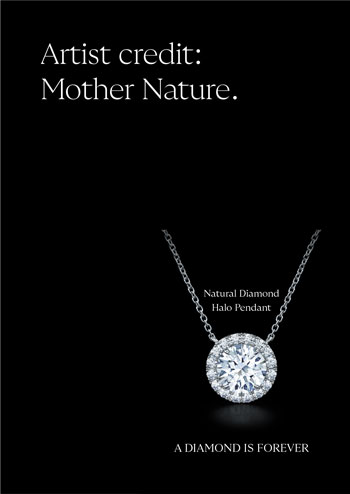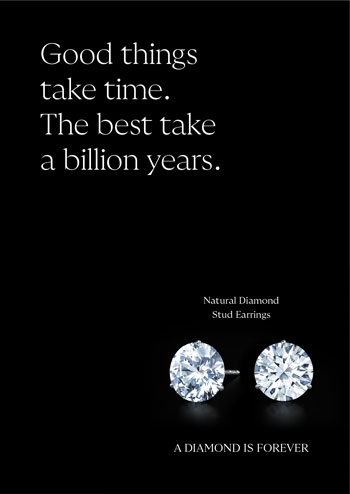Mined or lab-made?
That's ALWAYS the question when it comes to insuring diamond jewelry.

It took a while for lab-grown diamonds to catch on, but now that time has come. Briefly, here's the current picture:
- There are more and more diamond growers, and an increasing number of lab-grown diamonds (LGD) on the market.
- More competition means lower prices, which is a boon for jewelry customers.
- It's not a boon for diamond-growers. The second-largest producer of LGD in the U.S. has filed for bankruptcy because of the burgeoning glut of lab-made diamonds. U.S. growers are also competing with companies in China, where more than half the world's LGD are produced, and where wages are lower and quality oversight is likely to be looser.
- It's not a boon for retailers. Though they may sell more jewelry, LGD prices are lower. One industry observer says, "Every two years, the price [of lab-made diamond] halves, which means a retailer two years from now will have to sell twice as many carats to maintain their own flat margin."
- In short, insurers of jewelry should be aware of a shifting situation, with players rearranging themselves and pricing/valuations in flux.
Even De Beers was caught off balance. For many years, de Beers was disdainful of lab-made diamonds, insisting that only mined diamonds were "real" diamond. Then, a few years ago, De Beers premiered Lightbox, its own brand of lab-made diamond jewelry. It was hyped as fashion jewelry, appropriate for lighter events like birthdays or graduations. Jewelry commemorating serious emotional events, like engagements and anniversaries, merited only mined diamond, de Beers' original focus.
Then earlier this year Lightbox, responding to growing consumer interest, began offering lab-made engagement rings. But apparently that about-face didn't work out so well for the bottom line. So—two steps forward, one step back—after three months, Lightbox ended its "test" and will no longer sell LGD engagement rings, but will continue selling LGD fashion jewelry.
De Beers' new campaign for mined diamond
In the face of the growing taste for lab-grown, De Beers will return to promoting "natural' (i.e., mined) diamond, focusing on diamond's iconic status — a status due to De Beers' own advertising campaigns over the years.
De Beers is re-energizing its successful "A Diamond is Forever" tagline, and adding a number of new ones. Pre-holiday marketing will happen in traditional print and digital media as well as in "influencer-developed content" to draw younger consumers to the luxury jewelry market.
Meanwhile, purchases of lab-grown diamond continue to increase, as discussed in Lab-Made Diamonds in the Fast Lane, and the market remains in flux.
So this is the message to agents, underwriters, and adjusters:
Any diamond jewelry that comes up for insurance could have either mined or lab-made diamond. The distinction is important, because the valuation difference is huge. Check the docs!
FOR AGENTS & UNDERWRITERS
Lab-grown diamond can retail for as much as 75% below the price of a mined diamond of similar quality, so knowing whether a diamond is mined or lab-made is crucial.
Don't assume a diamond is mined just because the appraisal doesn't say it's lab-grown. The appraisal should specifically state whether the stone is mined or lab-made. Be sure to read all the fine print on the appraisal.
Gem-grading labs have received parcels with lab-grown diamonds mixed in with mined gems. How many lab-made stones have not been "caught" and are out in the marketplace being sold, and priced, as mined diamonds? The potential for overpayment on claims is enormous.
Although Lightbox no longer sells LGD engagement rings, it did for a few months, so these rings are still out there. And lab-grown diamond engagement rings from many sources are increasingly popular.
It's always best to ask for the sales receipt, which will likely reflect the value of the jewelry. A large discrepancy between purchase price and valuation may indicate a lab-made diamond with mined-diamond valuation; or it may point to an inflated valuation on a "feel good" appraisal used as a selling tool.
The market price for both lab-grown and mined diamonds is in flux, so keep valuations up to date, to keep premiums appropriate and to reflect the current market if a claim is made.
For diamond grading reports we recommend the following labs, and you can use these links to verify reports you receive. The lab reports distinctly state whether the diamond is mined or lab-made.
GIA Report Check
AGS Report Verification
GCAL Certificate Search
The best appraisal includes the JISO 78/79 appraisal form and is written by a qualified gemologist (GG, FGA+, or equivalent), preferably one who has additional insurance appraisal training. One course offering such additional training is the Certified Insurance Appraiser™ (CIA) course of the Jewelry Insurance Appraisal Institute.
FOR ADJUSTERS
Lab-made, man-made, laboratory-grown, created, cultured and synthetic are terms describing real diamond made in a lab.
Mined diamond has a substantially higher valuation than lab-made diamond. If the appraisal or lab report does not explicitly state whether the gem is mined or lab-grown, use every means possible to determine which it is. If possible, interview the seller!
Deliberate non-disclosure is always possible.
Be especially diligent with colored diamonds, which are very expensive for mined diamond but easily and inexpensively produced in the lab. For example, Lightbox (owned by De Beers) sells its pink and blue diamonds at the same price as its colorless diamonds.
Sales receipts and proof-of-payment docs are often helpful in establishing whether a diamond is mined or lab-made. Read the fine print!
Take note of brand names on the docs, as some names may indicate producers or retailers of lab-made stones.
On a damage claim, ALWAYS have the jewelry examined in a gem lab that has reasonable equipment for the job and is operated by a trained gemologist (GG, FGA+or equivalent), preferably one who has additional insurance appraisal training, such as a Certified Insurance Appraiser™.
©2000-2025, JCRS Inland Marine Solutions, Inc. All Rights Reserved. www.jcrs.com




